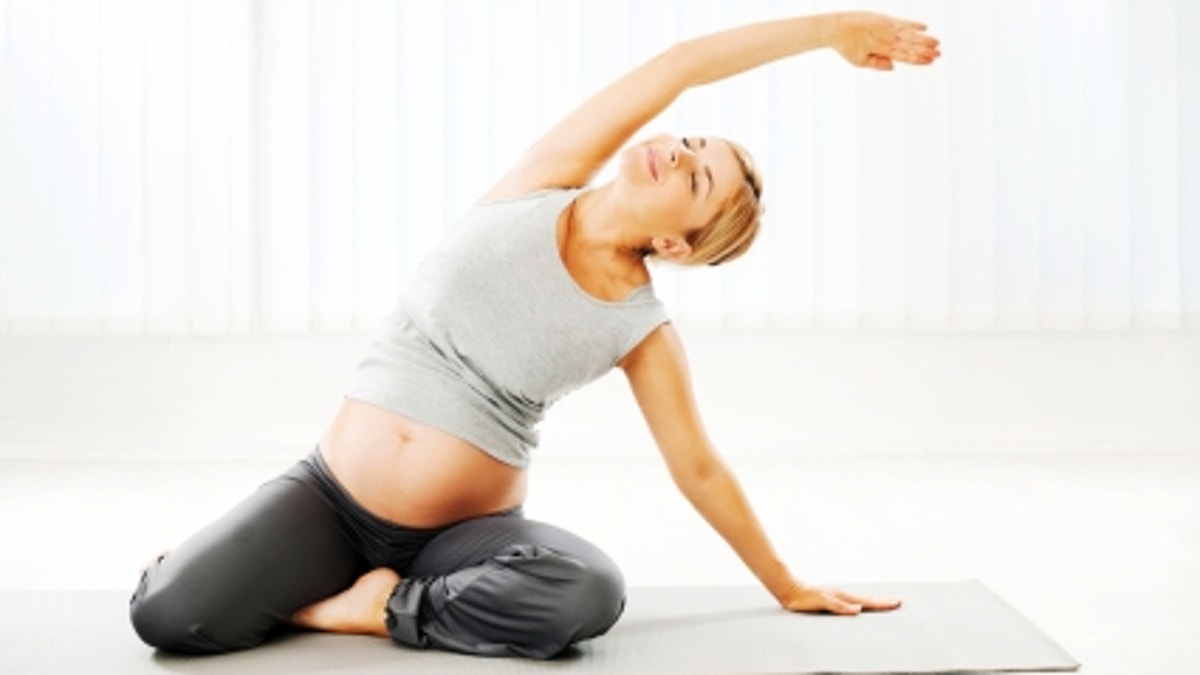
Beautiful pregnant woman doing stretching exercises.
Gone are the days when pregnancy meant becoming a couch potato. Today, many doctors and health professionals are encouraging women to work out throughout their pregnancy.
But what exercises are safe? One form of exercise that is favored by some medical experts and some of Hollywood’s newest moms (think, January Jones, Hilary Duff and Pink) is prenatal yoga.
“Yoga during pregnancy helps a woman increase her strength and flexibility, even as her body goes through the dramatic changes of pregnancy” says Mary Barnes, director and owner at Yoga for Two in New York. The postures yoga offers may also prepare women for childbirth and help relieve discomforts, such as back pain and swollen ankles.
Top 5 Ways to Stay Motivated During Pregnancy
If building strength and relieving pregnancy discomforts isn’t enough motivation, what about increasing pain tolerance? As yoga focuses on lengthening the breath, this creates endurance, calms the mind and can increase a woman’s pain threshold during labor.
But what if you are pregnant and new to yoga?
While it is often not recommended to begin a new exercise regiment during pregnancy, prenatal yoga is an exception.
“Starting a yoga practice during pregnancy can be a great way to bond with your baby,” said Amanda Schlesinger, who is certified to teach prenatal yoga and teaches privately in New York City.
While experienced yogis may continue attending their regular yoga classes, making necessary modifications, those who are new to yoga should attend a prenatal yoga class.
Mother's Guilt: Leaving Baby to Exercise?
“The sequences are modified for the pregnant body, and class sizes tend to be smaller so the instructor can offer more individualized attention,” Schlesinger said.
Here are some beneficial prenatal yoga positions:
1. Transverse abdominal strengthening. With your abdominal muscles, hug the baby to the spine and count to 30. Also slow, repeated pulses back toward the spine. Barnes explained that this may prevent the abs from atrophying throughout pregnancy, often eliminates diastisis recti (separation of the abdominal muscles). It also helps women push during birth and regain abdominal strength post-partum.
2. Kegals. Schlesinger recommended daily kegals, as they tone and strengthen the pelvic floor and support the growing uterus.
3. Pigeon pose. Begin in downward facing dog and bring your right knee towards your right wrist while angling your right shin under your torso. Slide left leg back and lower the outside of your right buttock to the floor. Repeat on other side. Schlesinger said this offers a great release due to the natural external rotation of the legs as the uterus and belly expand which may cause tightening of the piriformis muscle (lower glutes).
4. Standing poses to strengthen legs and gluteals.
• Virabadrasana I (Warrior I): From standing position, bring one leg back four feet. Turn back foot to 45 degree angle and keep back leg straight while keeping front foot straight and bend front knee 90 degrees. Extend arms perpendicular to floor and parallel to each other.
• Virabadrasana II (Warrior II): From standing position, bring one leg back four feet. Turn back foot out 90 degrees, and keep back leg straight while keeping front foot straight forward and bend front knee 90 degrees. Extend arms parallel to floor.
• Squats: Barnes said that later in pregnancy squatting helps the baby descend into the pelvis, and it's a good position ultimately to use during the pushing stage of childbirth. However, this should not be done if the baby is in a breech position.
Here are some poses to avoid (or modify).
1. Deep abdominal twists, which puts too much pressure on the uterus.
2. Deep back bends, such as “wheel pose.” This may cause the abdominal wall to separate.
3. Prone positions (lying on your back): According to the American Congress of Obstetricians and Gynecologists (ACOG) pregnant women may lay on their back until 20 weeks. Afterwards, the uterus puts extra pressure on the vena cava, a vein located on the right side of the body that, when compressed, decreases blood flow back to the heart. A semi-prone position may be used instead; elevate your back on an incline using two blocks and a bolster lying diagonally on top.
